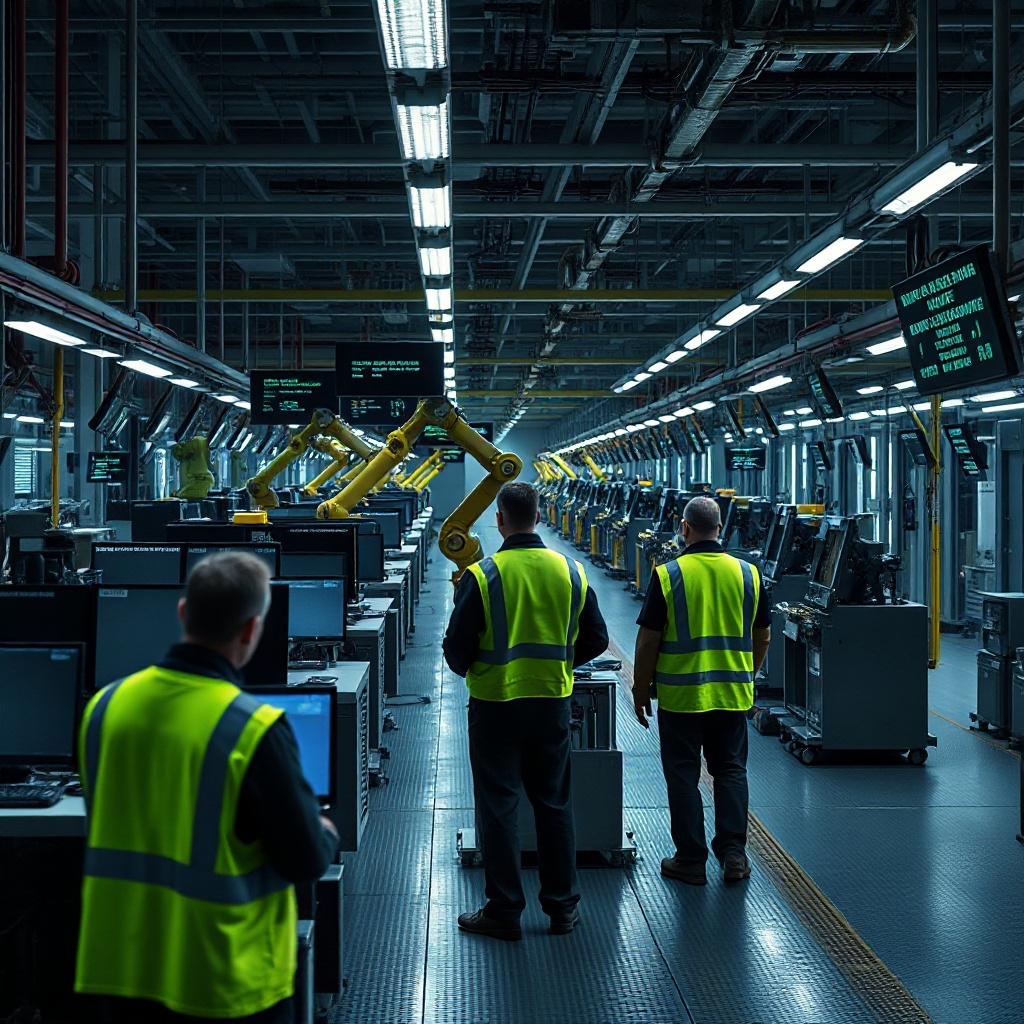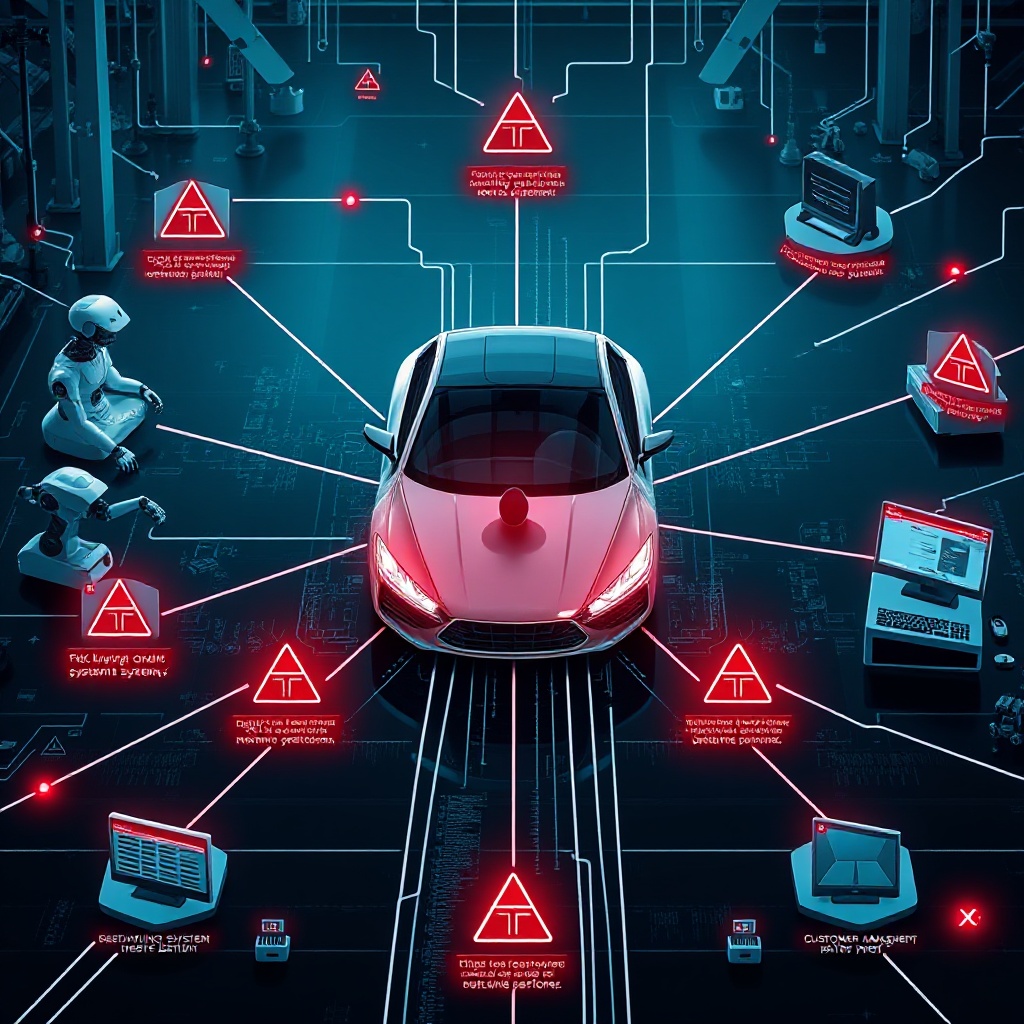
Cyberattack on Jaguar Land Rover reveals how interconnected manufacturing systems create massive vulnerabilities, instantly paralyzing production and demonstrating existential business risk.

Drivetech Partners
The September 2, 2025 cyberattack on Jaguar Land Rover (JLR) represents a watershed moment for automotive manufacturing security, revealing how deeply interconnected production systems create massive vulnerability when compromised. As the attack shut down JLR's entire global operation during a critical sales period, it demonstrated that cybersecurity failures can instantly paralyze billion-dollar manufacturing operations and ripple through international supply chains, transforming digital threats into existential business risks.
Key Takeaways
The attack paralyzed JLR production facilities and retail operations globally, demonstrating how digital breaches can instantly halt manufacturing operations
Manufacturing has become the most targeted industrial sector, accounting for 36% of all cyberattacks in 2024
The incident began with credential compromise and spread through interconnected systems, highlighting how smart factory architecture creates unprecedented risk exposure
Automotive cyberattack damages have exploded from $1 billion in 2022 to $22.5 billion in 2024
Companies must reframe cybersecurity as a core industrial resilience function rather than just IT responsibility

Unprecedented Digital Disruption: JLR Cyberattack Halts Global Operations
On September 2, 2025, a devastating cyberattack crippled Jaguar Land Rover's global operations, forcing an immediate production shutdown across key UK plants—most notably Halewood—and disrupting retail networks worldwide. The attack triggered a complete shutdown of global IT systems, manufacturing processes, and customer-facing operations during the critical September plate change sales period in the UK.
This crisis represents one of the most severe and far-reaching cyberattacks in automotive manufacturing history. The market responded quickly, with Tata Motors' shares falling 0.9% in Mumbai following the news announcement, signaling investor concerns about both immediate and long-term impacts on JLR's operations and financial stability.

Anatomy of the Attack: Technical Details and Breach Mechanics
Security analysis revealed the attack began with valid account compromise (MITRE ATT&CK T1078) and public-facing application exploit (T1190). The attackers demonstrated sophisticated lateral movement techniques using remote services (T1021) and system services misuse (T1569) to gain deeper access into JLR's network infrastructure.
The attackers deployed custom malware specifically designed for credential harvesting and data exfiltration through encrypted channels. Technical indicators of the breach included:
IP addresses: 192.0.2.45 and 203.0.113.88
Malicious domain: "jlr-malicious.com"
Malware hashes: fd4e2b9f6aef4c8d217bb73931a8cd9f and 45e7c9a8a9f3ab72bbd02a8b849dec1b
Registry modification targeting HKLM\Software\JLR\Config
These indicators point to an advanced persistent threat capability, suggesting a well-organized and potentially state-sponsored attack rather than opportunistic cybercriminals. The complexity of the attack highlights the sophisticated nature of threats now targeting automotive manufacturing.

The Vulnerable Digital Factory: Why Manufacturing Is Now Prime Target
The JLR attack isn't an isolated incident but part of a troubling trend. Manufacturing accounted for 36% of all cyberattacks in 2024, making it the most targeted industrial sector. This vulnerability stems from the rapid digitization of production facilities without corresponding security improvements.
Modern automotive manufacturing facilities have become prime targets for several reasons:
81% of automotive manufacturers now use networked hardware, computers, sensors, and instruments
84% employ production monitoring and quality management systems that create expansive attack surfaces
Smart factory architecture creates unprecedented risk exposure across engineering, production, and business operations
The automotive sector accounts for 26% of all cellular IoT connections worldwide, expanding the vulnerability footprint
IoT malware attacks targeting automotive systems have risen 45% in recent years. Each connected device—from assembly robots to quality control sensors—represents a potential entry point for attackers looking to disrupt operations or extract sensitive data.
Economic and Supply Chain Impact: Beyond the Factory Floor
The JLR cyberattack caused immediate and cascading economic impacts. Production and retail disruptions resulted in a critical operational standstill at JLR facilities, with industry estimates suggesting millions in losses per hour of idle factory time. Retailers were unable to process new car registrations or deliveries during the crucial plate-change period in the UK, further compounding financial damage.
The attack triggered ripple effects throughout JLR's global network of 800+ suppliers and thousands of retailers. These disruptions highlight how automotive manufacturing has become part of a broader industry-wide crisis where cyberattack-related losses surged from $1 billion in 2022 to an estimated $22.5 billion in 2024, broken down as:
$20 billion in data leakage damages
$1.9 billion in downtime costs
$538 million in ransomware damages
This massive increase in damages underscores how digital security has become inseparable from operational and financial stability in modern manufacturing.
Crisis Response and Containment Strategies
JLR's immediate response focused on containment and mitigation. The company quickly isolated affected systems and implemented company-wide emergency protocols to prevent further spread of the attack. Mandatory password resets and multi-factor authentication were deployed across all systems to secure remaining infrastructure.
Technical countermeasures included:
Security patches for vulnerable systems
Enhanced SIEM (Security Information and Event Management) monitoring implementation
Coordinated response with the UK National Cyber Security Centre and other government authorities
Prioritized protection of customer data systems
Initial investigations found no evidence of consumer data theft, suggesting the attackers' primary goal was operational disruption rather than data exfiltration. This response, while necessarily reactive, followed established best practices for cyber incident management in critical infrastructure.
Regulatory Framework and Government Intervention
The JLR incident triggered enhanced governmental oversight and security coordination with UK authorities. The scale of the attack and its impact on national manufacturing highlighted the importance of compliance with emerging regulations including the EU Cyber Resilience Act and NIS2 Directive.
The attack also emphasized how new NHTSA and SEC cybersecurity guidelines are becoming critical for automotive sector resilience. Government-industry cooperation is increasingly essential for national economic security protection, with regulatory requirements expanding to include industrial systems beyond traditional IT infrastructure.
This regulatory evolution reflects a growing recognition that automotive cybersecurity represents a matter of national economic security, not merely private sector risk management. The response to the JLR attack may accelerate the development of mandatory security standards for manufacturing systems.
Building Automotive Cybersecurity Resilience: The Path Forward
The JLR attack makes clear that cybersecurity must be reframed as a core industrial risk, not merely an IT function. For automotive manufacturers, several security principles have become essential:
Zero trust architecture implementation for manufacturing environments with complex supplier networks
Network segmentation between operational technology and IT networks to prevent lateral movement
Enhanced threat detection systems across all manufacturing and supply chain systems
Regular cybersecurity training for all staff, including factory floor personnel working with networked equipment
Implementation of resilience planning that accounts for complete system shutdown scenarios
These measures require significant investment but are increasingly viewed as essential operational costs rather than optional security enhancements. The cost of prevention is invariably lower than the cost of recovery after a major breach.
The New Manufacturing Security Paradigm
The automotive sector must integrate cybersecurity into product development and manufacturing processes from initial design through production. Advanced persistent threats require continuous monitoring and threat intelligence across all systems, with every networked device—from assembly robots to quality control sensors—recognized as a potential entry point.
A collaborative industry approach is needed to share threat intelligence and best practices. Resiliency planning must include cybersecurity as a fundamental pillar of manufacturing strategy. Consumer confidence in automotive brands is increasingly tied to digital trust and security capabilities.
The JLR attack marks a turning point in how automotive manufacturers must approach security. No longer can cybersecurity be treated as a secondary concern or isolated IT responsibility—it has become a core business function essential to operational continuity, financial stability, and brand trust in an increasingly connected manufacturing environment.
Sources
firecompass.com - Jaguar Land Rover Cyberattack 2025
industryweek.com - Why Automotive Manufacturing Fears Cybercrime
webpronews.com - Jaguar Land Rover Cyberattack Halts UK Manufacturing in 2025
zscaler.com - How Automotive Industry Can Secure Smart Factories
clearphish.ai - Jaguar Land Rover Cyberattack 2025 Production Sales Disruption






